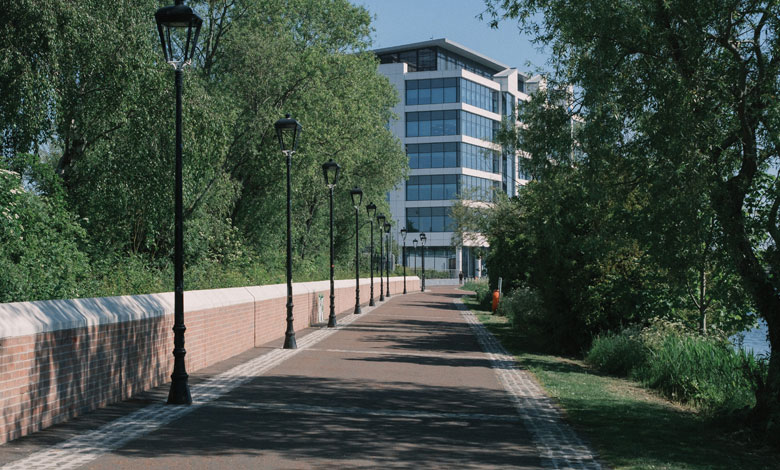
Blue Carbon Action Plan published
26th May 2025
The trusted voice
26th May 2025Johnathan Carlisle, Department for Infrastructure (DfI) project sponsor for the Belfast Tidal Flood Alleviation Scheme (BTFAS) walks agendaNi’s Ciaran Brennan through the scheme, explaining the consequences of a tidal flood event, and how BTFAS silently protects the people of Belfast.
Carlisle says that Belfast is at risk of flooding from multiple sources, but tidal is “of most concern”. He outlines the need for the scheme, with Belfast identified as the most at risk out of 20 significant flood risk areas in the 2011 Northern Ireland Flood Risk Assessment. A tidal event could result in 2km2 of flooding in Belfast city centre, according to Carlisle. The BTFAS project sponsor adds that there are currently over 1,500 properties at risk from tidal flooding.
“With the onset of climate change projected to cause sea level rise, this number is projected to increase,” he says. “If we need any further evidence of the change in climate, the five highest tidal surges in Belfast have been recorded in the past 30 years.
“Belfast, due to its topography, has a number of potential spill points along the quay walls and river banks. Parts of the city centre could be one to two metres below predicted significant tide levels. With potential tidal surges spilling over those quay walls and running into the city centre, it has the potential to cause significant economic damage and disruption to commerce, transport, and the social fabric of the city.”
In January 2014, Belfast experienced a significant tidal surge resulting in a major multi agency emergency response led by the PSNI which Carlisle pins as proof that there was “a real need for the scheme”. He traces how its benefits were already demonstrated in response to Storm Ashley during October 2024, even when construction had not yet been completed. Demountable defences were deployed in the Lockview area in response on this occasion.
The Scheme, which was completed in December 2024 at a cost of £33 million ultimately offers enhanced protection to over 3,000 homes and businesses from tidal flooding. Construction commenced in July 2022 and it was initially expected to cost £17 million, but a combination of inflation, significant challenges and changes during design development, including opportunities to reduce the length of temporary defences resulted in an increase in cost and programme. “Nevertheless the project retained a very healthy benefit cost ratio throughout.
Over the 100-year lifespan of the scheme, the direct costs of tidal flood risk damages in Belfast are estimated at £168 million, with an additional £87 million arising from impacts to the local economy.
The scheme was designed to provide “a high level of protection” up to the mid-2080s, and future adaptations could extend this by an additional 40 years.
Spanning 8.5km between Stranmillis Weir and Belfast Harbour, it includes works at five areas including Lockview/Stranmillis, Ormeau, Ravenhill, Sydenham, and the harbour/city centre. The scheme comprises permanent defences such as reinforced concrete, an earthen embankment, and glass defences, and temporary defences like stop logs, post and plank barriers, K-frame defences, rigid temporary flood barriers, and flood gates.
Integration
During the design process, an emphasis was placed on integrating the defences with existing streetscapes. Carlisle outlines the emphasis that was placed on achieving this during the delivery of the scheme. “There have been massive efforts to rejuvenate the River Lagan, the use of the river, and investment around the area. Trying to integrate with existing streetscapes was massively important, and a challenge for the project.”
To achieve this, the majority of flood defences were installed at the back of the towpath to maintain the width of the walkway, and the open vista to the river. Those who walk along the path will observe that the finishes on the concrete defences differ between sections so they blend in with the streetscape.
“That was a key challenge and hopefully we have been able to achieve that. Some of the feedback we have received is that people did not know that this was a flood defence which has been very pleasing,” he says. “We did not want to create dead spaces or sever that link of activity to the river. This is really well used and it is a great amenity.”
Railings along the quay wall have been replaced with glass defences, to maintain views to the river without compromising on functionality. Carlisle traces the challenges presented by integrating the defences with the existing structures and quay walls.
“Some of the more recent developments were built in accordance with current local planning regulations that they be elevated above the flood level which reduced the extent of defences that we needed to construct. One of the challenges was that some of the quay walls are decades old. Some may have been refurbished, some may have not. We were dealing with a multitude of different types of structure. Some may have needed additional works.”
The BTFAS project sponsor states that efforts were made to minimise the impact on the local environment and wildlife. Vegetation clearance had to take place along the 8.5km length of the project, but Carlisle explains that hedges and bushes were replanted or transplanted where possible, while three new trees were planted for every mature tree removed. He adds: “Obviously there are environmental sensitivities in Belfast Lough. The River Lagan is hydrologically linked to Belfast Lough. So we tried to minimise the impact on the river corridor as much as possible.”
Access
Carlisle details how access to the river is maintained: “Obviously a scheme that extends over this sort of length, there are multiple points of access. It is a much used amenity.
We needed to maintain that access. There are numerous points where the line of defences cross over roadways, so it is not physically possible to build a solid wall.”
To maintain access, temporary measures such as stop logs, post and plank barriers, K-frame defences, temporary flood barriers and flood gates are ready to deploy in the event of a tidal flood event. Operatives from the Department will be deployed in such an event to install the temporary defences, with materials for the temporary measures stored in nearby containers. Carlilse says: “That is to cut down transportation and the logistics of getting it here when it needs to be here.”
Deployment of DfI operatives is informed by the multi-agency Coastal Response Plan which is due to be updated on foot of the completion of the scheme. To enable a timely response to tidal flood events, the Department receives tidal forecasts from the Met Office five days out which are refined as the tidal event approaches.
Minister for Infrastructure Liz Kimmins MLA visited the scheme in March 2025, saying: “Adapting to climate is one of my Department’s seven foundations for a better future. While we cannot prevent all flooding from happening, we can reduce the impacts with appropriate infrastructure investment. The completion of this £33 million scheme is a major boost for over 3,000 homes and businesses not only today but also for future generations as we bolster our defences to help protect against tidal flooding.
“Completion of this project means the city will be better prepared for future tidal flooding events, safeguarding both people and infrastructure whilst also promoting long term resilience. We are already experiencing a change in our weather with increasingly severe storms and the design of these flood defences takes into account climate change projections to 2080.
“This work is part of an ongoing programme in flood risk management. Significant investment is required to provide vital new infrastructure such as the Belfast Tidal Flood Alleviation Scheme but also to upgrade existing flood defences across the North and address years of historic under-investment in this area.
“I would also like to commend the team who have designed the defences to integrate with their surroundings. This vital work contributes to protecting a thriving city where people want to live and work, to visit and invest – both now and in the future.”






 Ossian Smyth TD
Ossian Smyth TD Florika Fink-Hooijer
Florika Fink-Hooijer Antoine Oger
Antoine Oger Laura Curtis-Moss
Laura Curtis-Moss Anthony Costello
Anthony Costello Anja Murray
Anja Murray Niall Ó Donnchú
Niall Ó Donnchú Mike Savage
Mike Savage Brian Carroll
Brian Carroll Claire Downey
Claire Downey Oisín Coghlan
Oisín Coghlan Stephen Onakuse
Stephen Onakuse Kevin O’Sullivan
Kevin O’Sullivan Susan Hegarty
Susan Hegarty Hendrik W van der Kamp
Hendrik W van der Kamp Philip Nugent
Philip Nugent Adrian Smyth
Adrian Smyth Ainhoa Gonzalez Del Campo
Ainhoa Gonzalez Del Campo Geoff Doole
Geoff Doole Clare Pillman
Clare Pillman David Greenfield
David Greenfield Danielle Conaghan
Danielle Conaghan Peter McEvoy
Peter McEvoy Triona McGrath
Triona McGrath J Owen Lewis
J Owen Lewis Gavin Smith
Gavin Smith Imelda Hurley
Imelda Hurley Lucy Gaffney
Lucy Gaffney Dr Venkatesh Kannan
Dr Venkatesh Kannan Kevin Hegarty
Kevin Hegarty Eimear Cotter
Eimear Cotter Aditya Arora
Aditya Arora Patric Child
Patric Child Eleanor Roche
Eleanor Roche Andy Bleasdale
Andy Bleasdale Andrew Muir MLA
Andrew Muir MLA Chris Hewitt
Chris Hewitt Francesca Racioppi
Francesca Racioppi Danielle Conaghan
Danielle Conaghan Christopher Hammond
Christopher Hammond Laura Díaz Anadón
Laura Díaz Anadón Lorna McAdoo
Lorna McAdoo Conor Murphy
Conor Murphy Mark Horton
Mark Horton Niall McLoughlin
Niall McLoughlin Zoe Kavanagh
Zoe Kavanagh Niall Ó Donnchú
Niall Ó Donnchú Venkatesh Kannan
Venkatesh Kannan David McGee
David McGee Anna Rose
Anna Rose Paul Hogan
Paul Hogan






















 Levent Ergin
Levent Ergin Veronica Manfredi
Veronica Manfredi Francis Finnerty
Francis Finnerty  Timmy Dooley TD
Timmy Dooley TD  Julie Thompson
Julie Thompson  Mark Thuillier
Mark Thuillier  Martin Hutchings
Martin Hutchings  Mark Nolan
Mark Nolan